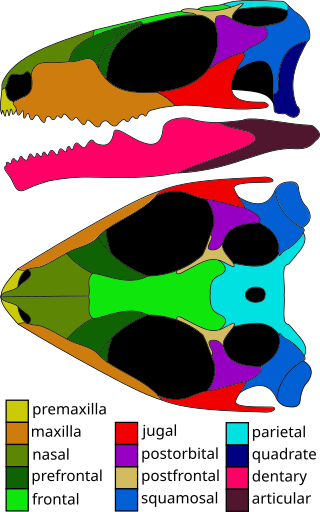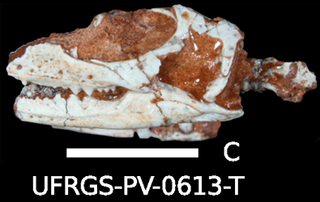
Rhynchocephalia is an order of lizard-like reptiles that includes only one living species, the tuatara of New Zealand. Despite its current lack of diversity, during the Mesozoic rhynchocephalians were a speciose group with high morphological and ecological diversity. The oldest record of the group is dated to the Middle Triassic around 238 to 240 million years ago, and they had achieved global distribution by the Early Jurassic. Most rhynchocephalians belong to the group Sphenodontia ('wedge-teeth'). Their closest living relatives are lizards and snakes in the order Squamata, with the two orders being grouped together in the superorder Lepidosauria.

Planocephalosaurus is an extinct genus of basal rhynchocephalian. Fossils of the genus are primarily known from fissure fill deposits from the Late Triassic of southwest Britain, with fragmentary remains possibly belonging to the genus also known from the Late Triassic of Texas.

Pleurosauridae is an extinct family of sphenodontian reptiles, known from the Jurassic of Europe. Members of the family had long-snake like bodies with reduced limbs that were adapted for aquatic life in marine environments. It contains two genera, Palaeopleurosaurus, which is known from the Early Jurassic (Toarcian) Posidonia Shale of Germany, as well as Pleurosaurus from the Late Jurassic of Germany and France. Paleopleurosaurus is more primitive than the later Pleurosaurus, with a skull similar to those of other sphenodontians, while that of Pleurosaurus is highly modified relative to other sphendontians. They likely swam via anguilliform locomotion. Vadasaurus and Derasmosaurus from the Late Jurassic and Early Cretaceous of Europe have been placed as part of this family in some studies, but lack the body elongation that typifies the other two genera.

Brachyrhinodon is an extinct genus of sphenodontian from the Late Triassic Lossiemouth Sandstone of Scotland.

Clevosaurus is an extinct genus of rhynchocephalian reptile from the Late Triassic and the Early Jurassic periods. Species of Clevosaurus were widespread across Pangaea, and have been found on all continents except Australia and Antarctica. Five species of Clevosaurus have been found in ancient fissure fill deposits in south-west England and Wales, alongside other sphenodontians, early mammals and dinosaurs. In regards to its Pangaean distribution, C. hadroprodon is the oldest record of a sphenodontian from Gondwana, though its affinity to Clevosaurus has been questioned.

Diphydontosaurus is an extinct genus of small rhynchocephalian reptile from the Late Triassic of Europe. It is the most primitive known member of Sphenodontia.

Gephyrosaurus is an extinct genus of lepidosaurian reptile known from the Late Triassic to Early Jurassic of the United Kingdom. It is generally considered to be one of the most primitive members of the clade Rhynchocephalia.
Godavarisaurus is an extinct genus of sphenodontian reptile from the Early-Middle Jurassic Kota Formation of Andhra Pradesh, India. It is known from jaw fragments. It was a small sphenodontian, with the skull estimated to be less than 2 centimetres (0.79 in) long. It is generally considered to be a relatively basal sphenodontian that lies outside Eusphenodontia.

Sphenotitan is an extinct genus of rhynchocephalian reptile, known from the Late Triassic (Norian) Quebrada del Barro Formation of Argentina. It is the earliest known member of the herbivorous Elienodontinae, and the only one known from the Triassic. It was a large-sized sphenodontian, with an estimated skull length of over 10 centimetres (3.9 in). The skull is roughly triangular in shape, and had large upper temporal fenestrae. The region of the skull in front of the eye socket is short. The premaxillae forms beak, with a cutting edge similar to a chisel. The teeth of Sphenotitan, like other elienodontines, were large and wide, and designed for shredding vegetation, with blade-like palatal teeth on the roof of the mouth.
Whitakersaurus is a genus of sphenodontid rhynchocephalian reptile dated to be late Triassic in age and is from the Ghost Ranch fossil quarry in New Mexico, USA. It is named after the discoverer of the Ghost Ranch quarry, George O. Whitaker. The fossil was described in 2007.
Rebbanasaurus is an extinct sphenodontian reptile known from remains found in the Early-Middle Jurassic Kota Formation of India. The type specimen is a partial jawbone which has acrodont teeth, with other known remains including fragments of the premaxilla, maxilla, and palatine. It was relatively small, with a skull estimated at 1.5–2.5 centimetres (0.59–0.98 in) long. It is generally considered to be a relatively basal sphenodontian that lies outside Eusphenodontia.

Opisthodontia is a proposed clade of sphenodontian reptiles, uniting Opisthias from the Late Jurassic-earliest Cretaceous of Europe and North America with the Eilenodontinae, a group of herbivorous sphenodontians known from the Late Triassic to Late Cretaceous.

Clevosaurs are an extinct group of rhynchocephalian reptiles from the Triassic and Jurassic periods.

Polysphenodon is an extinct genus of sphenodontian reptile with a single species Polysphenodon mulleri from the Late Triassic Keuper Group of Germany.

Sapheosaurs are an extinct group of rhynchocephalian reptiles from the Late Jurassic period. "Sapheosaurs" is an informal name for a group of rhynchocephalians closely related to the genus Sapheosaurus. It was first recognized as a group containing multiple genera by Hoffstetter in 1955. The group has sometimes been given a formal taxonomic name as the family Sapheosauridae, although in some analyses this group belongs to the family Sphenodontidae and thus cannot be assigned its own family. They were fairly advanced rhynchocephalians which may have had semiaquatic habits.

Microsphenodon is an extinct genus of sphenodontian from the Late Triassic of Brazil. The type species is Microsphenodon bonapartei. It is a small sphenodontian with a skull roughly 20 mm long, and represents a unique mosaic of characteristics shared by both early diverging sphenodontians and eusphenodontian characters. Specimens of this taxon were first identified by Bonaparte and Sues (2006) but were misidentified as juvenile Clevosaurus brasiliensis, characteristics such as differences in the configuration of the teeth on the palate, and the unique form of tooth implantation seen in C. brasiliensis, helped differentiate these two co-occurring sphenodontian taxa.
Lanceirosphenodon is an extinct genus of sphenodontian from the Late Triassic Candelária Formation of Brazil. It contains a single species, Lanceirosphenodon ferigoloi.
Fraserosphenodon is an extinct genus of sphenodontian from the Late Triassic of the United Kingdom. It contains a single species, Fraserosphenodon latidens.
Penegephyrosaurus is an extinct genus of early rhynchocephalian from the Late Triassic of the United Kingdom. It contains a single species, Penegephyrosaurus curtiscoppi. It is only known from a partial lower jaw. It is considered one of the most basal known rhynchocephalians and is placed as part of the family Gephyrosauridae.
Paleollanosaurus is an extinct genus of sphenodontian reptile that lived during the Late Triassic. The type species P. fraseri was described from a jaw fragment found in West Texas in North America. Remains have also been reported from Switzerland. It is generally considered a basal sphenodontian. Cladogram following Chambi-Trowell et al., 2021.













